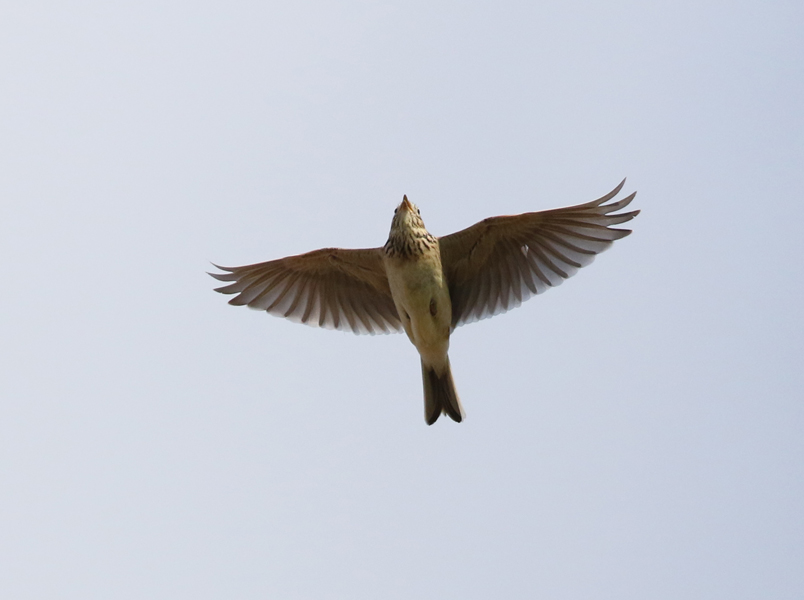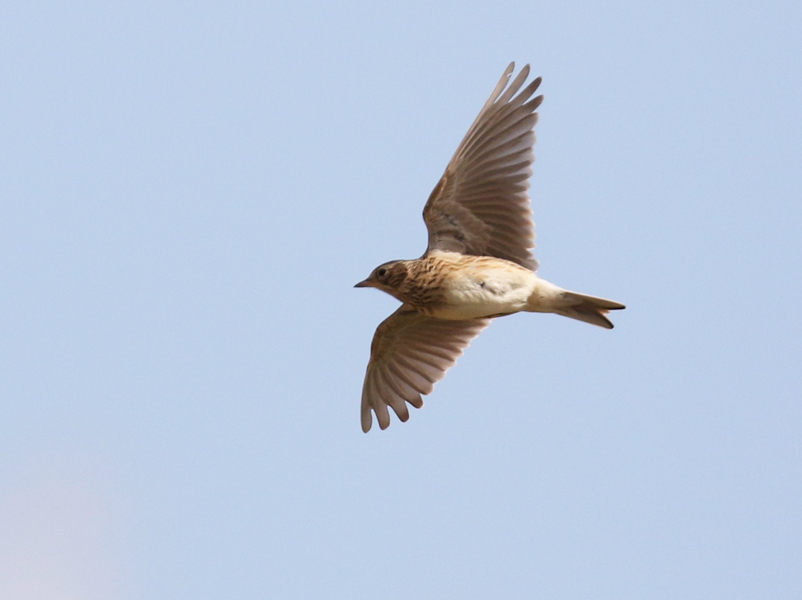
Early this morning I opened the window to the sound of Skylarks singing in the early morning sunshine. With grassy fields and arable land right in front of the hosue this is a very familiar sound to me but through the autumn and winter, although skylarks do sing, I rarely hear them sustaining long song flights. Today was different, with several birds singing for quite long periods of time, so after breakfast I decided to walk around the many footpaths and farm tracks around the area and try to get some photographs of Skylarks in song flight. This is something I have tried to do half-heartedly before, with little success, but today I did get a bit more luck.
While photographing Skylarks I noticed a few things about their behaviour, particularly the length of the song flight in the rapidly changing conditions which made me look for more information in journals and reference books, which I will talk about here.
When I sat, eating breakfast it was notable that in mostly blue skies, with a breeze, the local skylarks were in song flight for some time. I did not make any proper field notes on how long they were lasting but I could hear a few birds that sang for at least several minutes. However, by the time I was ready to go out the weather had begun to change, with some cloud cover and conditions becoming more blustery. As I walked the very short distance to the nearest public footpath I still heard Skylarks in song flight but instead of prolonged song from one single bird I noticed that although to my ear there was constant Skylark song, it was not coming from a single bird for any length of time. Instead bursts of song for 30 seconds to 1 minute came from one bird and then a burst of song from another bird, or birds, would take over. Such is the abundance of Skylarks in this area that in this way the air was filled with Skylark song without any one bird singing for any great length of time.
With Skylarks popping up, whizzing around and resettling on the ground all around me it was tricky to focus on any one bird to get photographs.
I have read before that Skylark song flight can last long periods of time and a little research revealed that it can last up to 30 minutes, although average duration is around 4 minutes when conditions are right – Song Flight Performance in the Skylark Alauda avensis. Presumably the conditions were not right today because very few birds were in song flight for anything like 4 minutes although I did come across a few birds that soared for some time, allowing me to photograph them from below.
The second bird pictured above soared in song flight for 2-3 minutes, getting to a hundred metres or so above the ground. This was probably the longest song flight I observed and made after reading the abstract of the study in the above link, I wondered if the short song was due to blustery wind conditions. The study suggests that the fluttering flight Skylarks perform at the highest point of their song flight does not require as much energy as one might think when the wind conditions are right. presumably this means that when wind conditions are not right, the amount of energy required is more and consequently Skylarks will sing for shorter periods.
Alternatively perhaps Skylark song flight is typically shorter at the start of the breeding season?
One of my favourite bird books is “The Skylark” by Paul Donald. This book discusses the ecology and behaviour of all species and forms of the world’s Skylarks, with a focus on Eurasian Skylark.

When I first read this it was a moment of enlightenment because I had always watched Skylarks and been amazed at their performances in terms of how much energy they use. The performances are no less impressive but now quite a lot easier to understand.
I spent a few hours in more or less the same spot, giving me a chance to watch the Skylarks in detail and another thing I noticed was quite a lot of song being delivered from the ground. I know this is something that Skylarks sometimes do, but I have grown up alongside Eurasian Skylarks and it is something I rarely see them do here. However, on this occasion I saw several birds doing it and again I wondered if this was anything to do with the very blustery conditions. Presumably if conditions are not good for song flight then song might be delivered from the ground in the breeding season.
Over the next few weeks I will take the opportunity to watch the local Skylarks and see how weather conditions affect the duration of their song flight. I will try timing some of them to see what the longest song flight of the local birds is. Luckily, right here they are a very abundant bird.


 March 28th, 2021
March 28th, 2021  Nick
Nick 






 Posted in
Posted in  Tags:
Tags: 









